Bennemann K.H., Ketterson J.B. Superconductivity: Volume 1: Conventional and Unconventional Superconductors; Volume 2: Novel Superconductors
Подождите немного. Документ загружается.

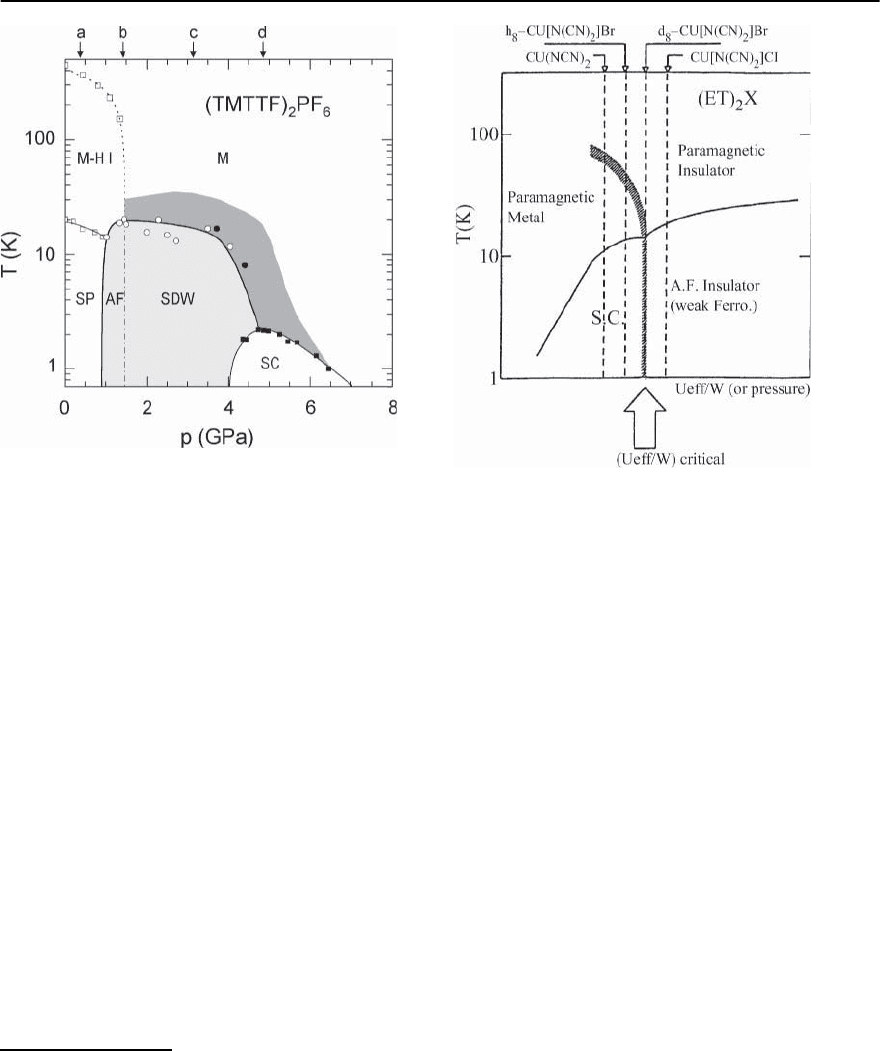
1180 M. Lang and J. M¨uller
Fig. 20.23. Temperature-hydrostatic-pressure phase dia-
gram for (TMTTF)
2
PF
6
. The abbreviations are: Mott–
Hubbard insulating state (M-H I), metallic (M) and su-
perconducting (SC) state,spin-Peierls (SP), commensurate
(AF) and incommensurate(SDW) antiferromagnetic spin-
density-wavestate.Arrows: ambient-pressure ground-state
location of other salts; (a) (TMTTF)
2
BF
4
,(b) (TMTTF)
2
Br,
(c) (TMTSF)
2
PF
6
,(d) (TMTSF)
2
ClO
4
(taken from [67])
by the shaded region above the SDW and SC phase
boundaries.
-(BEDT-TTF)
2
X Salts
Figure 20.24 shows a conceptual phase diagram pro-
posed by Kanoda for the dimerized -type BEDT-
TTF salts. Here it has been assumed that it is
the effective on-site (dimer) Coulomb interaction
U
eff
normalized to the bandwidth W which is the
key factor associated with the various phases and
phase transitions [95,96]. The positions of the vari-
ous salts are determined by their ambient-pressure
ground-state properties. The deuterated -(D
8
-
ET)
2
Cu[N(CN)
2
]Brsaltissituated right at theAFI/SC
border.The system lies in between the antiferromag-
Fig. 20.24. Conceptual phase diagram for -phase (ET)
2
X
as proposed by Kanoda [96]. Note that hydrostatic pres-
sure decreases the ratio U
eff
/W , i.e. the low pressure side
is on the right end of the phase diagram. The arrows indi-
cate the ambient-pressure position of the various systems
and AF and SC denote an antiferromagnetic insulator and
superconductor, respectively
netic insulating X = Cu[N(CN)
2
]Cl and the super-
conducting hydrogenated -(H
8
-ET)
2
Cu[N(CN)
2
]Br
salts.It has been proposed that a partial substitution
of the 2 × 4 H-atoms by D-atoms allows for fine-
tuning the -(ET)
2
Cu[N(CN)
2
]Br system across the
AFI/SC border [184–186]. The close proximity of an
antiferromagnetic insulating to a superconducting
phase has been considered, in analogy to the high-T
c
cuprates,as a strong indication that both phenomena
are closely connected to each other [4].
Figure 20.25 summarizes experimental data of a
detailed thermodynamic study on the various -
(ET)
2
X compounds in a pressure-temperature phase
diagram [99,187]. The positions of the various salts
at ambient pressure are indicated by the arrows.
7
The solid lines representing the phase boundaries
7
Note that hydrostatic pressure has been used as an abscissa for the purpose of compatibility with the conceptual
phase diagram in Fig. 20.24. It has been found, however, that the uniaxial-pressure dependences for the various phase
boundaries are strongly anisotropic [99,100,151] with a non-uniform behavior for the uniaxial-pressure coefficients
of both the density-wave instability at T
∗
and those of T
c
, cf. Figs. 20.17 and 20.32.
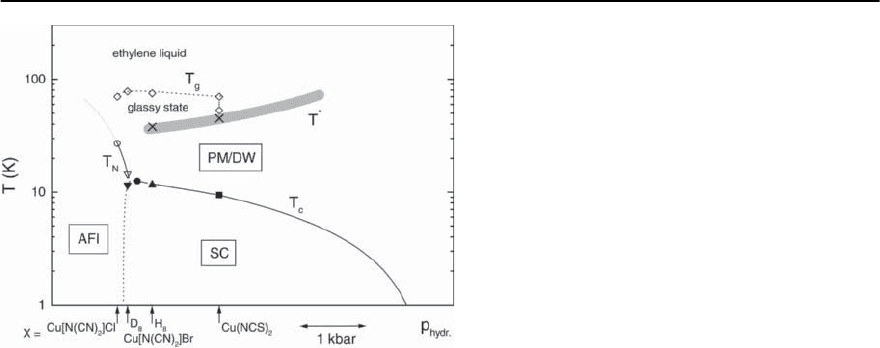
20 Organic Superconductors 1181
Fig. 20.25. Temperature-hydrostatic-pressure phase diagram for the -(ET)
2
Xcompounds.Arrows indicate the positions
of the various compounds at ambient pressure. Circles correspond to results on -(ET)
2
Cu[N(CN)
2
]Cl while down and
up triangles indicate phase-transition temperatures on deuterated and hydrogenated -(ET)
2
Cu[N(CN)
2
]Br, respectively,
and squar es stand for results on -(ET)
2
Cu(NCS)
2
.The transitionsinto the superconducting and antiferromagneticstates
are represented by closed and open symbols, respectively. Diamonds denote the glass-like freezing of ethylene disorder
and crosses the density-wave (DW) transition on minor parts of the Fermi surface.These anomalies coincide with various
features observed in magnetic, transport and acoustic properties (shaded area, see Sect. 20.3.3) (taken from [99,187])
between the paramagnetic (PM) and the supercon-
ducting (SC) or antiferromagnetic insulating (AFI)
states refer to the results of hydrostatic-pressure
studies of T
c
and T
N
[80, 188, 189]. The metal–
insulator transition and the coexistence range of
metallic/superconducting and insulating phases as
deduced from hydrostatic pressure experiments by
Lefebvre et al. [191] and Limelette et al. [98], see also
Fig. 20.26 below, is not addressed in this phase dia-
gram.
At elevated temperatures, a glass-like transition at
a temperature T
g
(dotted line) has been identified. It
marks the boundary between an ethylene-liquid at
T > T
g
and a glassy state at T < T
g
.Whileattem-
peratures above T
g
, the motional degrees of freedom
of the ethylene endgroups are excited with an equal
occupancyforthetwopossibleethyleneconforma-
tions, a certain disorder becomes frozen in at tem-
peratures below T
g
. The glass-like transition which
is structural in nature has been shown to cause time
dependences in electronic properties and may have
severe implications on the ground-state properties
of the -(ET)
2
Cu[N(CN)
2
]Br salt depending on the
cooling rate employed at T
g
(see Sect. 20.3.4).
At intermediate temperatures T
∗
,anomaliesinthe
coefficient of thermal expansion have been found
and assigned to a density-wave transition involving
only the quasi-1D parts of the Fermi surface. These
anomalies coincidewith variousfeatures observed in
magnetic, transport and acoustic properties (thick
shaded line in Fig. 20.25, see also Sect. 20.3.3). In
[99,100] it has been proposed that instead of a pseu-
dogap on the quasi-2D parts of the Fermi surface, a
real gap associated with a density wave opens on the
minor quasi-1D parts below T
∗
, see also [101]. This
scenario implies that the density wave and supercon-
ductivity involve disjunct parts on the Fermi surface
and compete for stability.
Details of the pressure-temperature phase dia-
gram of the antiferromagnetic insulating salt -
(ET)
2
Cu[N(CN)
2
]Cl have been reported by Ito et
al. [190], Lefebvre et al. [191], and, more recently,
by some other authors [98, 192, 193]. In [191], it
has been shown that the superconducting and an-
tiferromagnetic phases overlap through a first-order
boundary that separates two regions of an inhomo-
geneous phase coexistence [191]. It has been argued
that this boundary curve merges with a first-order
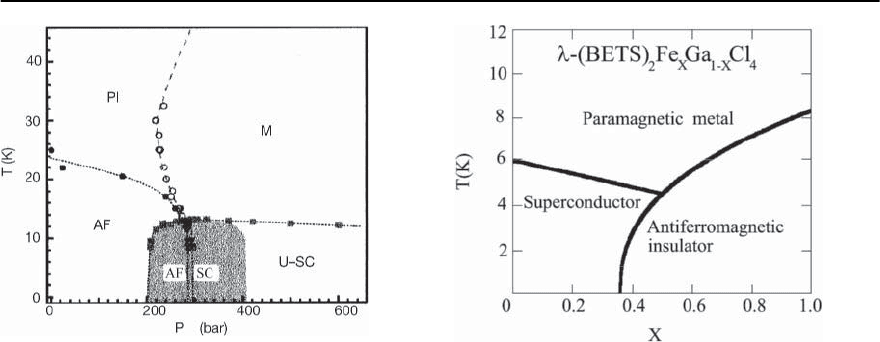
1182 M. Lang and J. M¨uller
Fig. 20.26. Pressure-temperature phase diagram for -
(ET)
2
Cu[N(CN)
2
]Cl. The antiferromagnetic (AF) tran-
sition temperature T
N
(p)(closed circles) were deter-
mined from the NMR relaxation rate while T
c
(p)(closed
squares)andT
MI
(p)(open circles) were obtained from
ac-susceptibility measurements. U-SC denotes uniform
superconductivity; the AF-SC boundary line separates
two regions of inhomogeneous phase coexistence (shaded
area) (taken from [191])
line of the metal–insulator transition and that this
line ends at a critical point at higher temperature,
see Fig. 20.26. The figure also suggests the existence
of a point-like region where the metallic, insulating,
antiferromagnetic as well as superconductingphases
all meet. This would imply the absence of a bound-
ary between metallic and complete antiferromag-
netic phases which would be incompatible with an
itinerant type of magnetism [191].Bymeasurements
of the ultrasonic velocity on pressurized -(BEDT-
TTF)
2
Cu[N(CN)
2
]Cl [192] a dramatic anomaly has
been observed near 34 K and at P 210 bar which
defines the criticalpoint in the pressure-temperature
plane.
(BEDT-TSF)
2
X Salts
Figure 20.27 shows the phase diagram for the quasi-
2D alloy system -(BETS)
2
Fe
x
Ga
1−x
Cl
4
whichhas re-
cently gained strong interest due to its interesting
magnetic and superconductingproperties [194].The
system is based on the donor molecule BEDT-TSF or
simply BETS which represents the Se analogue to
BEDT-TTF, see Sect. 20.2. -(BETS)
2
GaCl
4
on the
Fig. 20.27. Phase diagram for -(BETS)
2
Fe
x
Ga
1−x
Cl
4
taken
from [32]
left side is a nonmagnetic salt which becomes su-
perconducting at T
c
= 6 K [31]. A magnetic field of
13 T aligned parallel to the highly conducting planes
destroys superconductivity and stabilizes a param-
agneticmetallicstate.Conversely,-(BETS)
2
FeCl
4
shows a metal–insulator (M–I) transition around 8 K
which is accompanied by an antiferromagnetic or-
der of the Fe
3+
moments in the anion layers [28].
Applying a magnetic field in excess of about 10 T
destabilizes the insulating phase and the paramag-
netic phase recovers [195, 196]. In the mixed se-
ries -(BETS)
2
Fe
x
Ga
1−x
Cl
4
, the M–I transition be-
comes suppressed as the concentration x of magnetic
Fe ions decreases and a superconducting ground
state is formed for x ≤ 0.35. A striking feature is
the metal–superconductor–insulator transition for
0.35 ≤ x ≤ 0.5,see Fig.20.27.Apparently,the various
phases contained in the above phase diagram orig-
inate from an intimate coupling between the mag-
netic moments of the Fe
3+
3d electrons and the -
conduction-electron spins of the BETS molecule,see
e.g. [32,196,197].
20.4 Superconducting-State Properties
Since the discovery of superconductivity in pressur-
ized (TMTSF)
2
PF
6
in 1979 [1], continuing efforts to
design new potential donor and acceptor molecules
have led to more than about 80 organic supercon-

20 Organic Superconductors 1183
ductors.
8
In the vast majority of cases, the donor
molecules are derivatives of the prototype TMTSF
molecule including BEDT-TTF as well as the sele-
niumandoxygensubstitutedvariantsBEDT-TSF and
BEDO-TTF, respectively. In addition, superconduc-
tors have been derived using asymmetric hybrids
such as DMET and MDT-TTF. For a comprehensive
list of organic superconductors the reader is referred
to [5].
In the following discussion of superconducting
properties we will confine ourselves to a few selected
examples. These are the (TMTSF)
2
Xandthequasi-
2D (BEDT-TTF)
2
X and (BEDT-TSF)
2
Xsaltswhich
arerepresentativeforawideclassofmaterials.
20.4.1 The Superconducting Phase Transition
Organic superconductors are characterized by a
highly anisotropic electronic structure, a low charge
carrier concentration and unusual lattice properties.
As will be discussed below, the combination of these
unique material parameters lead to a variety of re-
markable phenomena of the superconducting state
such as pronouncedthermal fluctuations,an extraor-
dinarily high sensitivity to external pressure and
anomalous mixed-state properties.
Superconducting Anisotropy
The abruptdisappearance of the electrical resistance
is one of the hallmarks that manifests the transi-
tion from the normal into the superconducting state
for usual 3D superconductors. For the present low-
dimensional organic superconductors, as in the lay-
ered high-T
c
cuprates, however, strong fluctuations
of both the amplitude and phase of the supercon-
ducting order parameter may cause a substantial
broadening of the superconducting transition. This
becomes particularly clear when a strong magnetic
field is applied.As a consequence, for these materials
zero-resistance is no longer a good measure of the
superconducting transition temperature in a finite
magnetic field. Therefore, for a precise determina-
tion of the upper critical fields, thermodynamic in-
vestigations such as magnetization, specific heat or
thermal expansion measurements are necessary.
Formaterialswith strongly directional-dependent
electronic properties, a highly anisotropic supercon-
ducting state is expected as well. In an attempt to ac-
count for these anisotropies, the phenomenological
Ginzburg–Landau and London models have been ex-
tended by employing an effective-mass tensor [199].
In the extreme case of a quasi-2D superconduc-
tor characterized by a superconducting coherence
length perpendicular to the planes,
⊥
, being even
smaller than the spacing between the conducting lay-
ers,s,these anisotropic 3D models are no longer valid.
Instead, the superconductor has to be described by
a model that takes the discreteness of the structure
into account. Such a description is provided by the
phenomenological Lawrence–Doniach model [200]
which encloses the above anisotropic Ginzburg–
Landau and London theories as limiting cases for
⊥
> s. This model considers a set of superconduct-
ing layers separated by thin insulating sheets imply-
ing that the 3D phase coherence is maintained by
Josephson currents running acrosstheinsulating lay-
ers. In fact, the presence of an intrinsic Josephson ef-
fect has been demonstrated for several layered super-
conductors including some of the high-T
c
cuprates
and the present -(ET)
2
Cu(NCS)
2
salt [201,202].
To quantify the degree of anisotropy, it is con-
venient to compare the results of orientational-
dependent measurements with the above anisotropic
models. For layered systems such as the present
(BEDT-TTF)
2
X compounds, it is customary to use
the effective-mass ratio = m
∗
⊥
/m
∗
,wherem
∗
⊥
and
m
∗
denote the effective masses for the superconduct-
ing carriersmoving perpendicular and parallel to the
conducting planes, respectively. In the London and
Ginzburg–Landau theories, is directly related to
the anisotropies in the magnetic penetration depths
and coherence lengths by
√
=
⊥
=
⊥
. (20.8)
8
The materials discussed in this article have to be distinguished from another class of molecular superconductors; the
alkali-metal-doped fullerenes discovered in 1991 [198], which are usually not referred to as organic materials as they
contain only carbon atoms.

1184 M. Lang and J. M¨uller
Fig. 20.28. Coefficient of
thermal expansion of ˇ
-
(ET)
2
SF
5
CH
2
CF
2
SO
3
mea-
sured parallel (left panel)
and perpendicular (right
panel) to the conducting
planes in varying fields ap-
plied along the measur-
ing directions (taken from
[151])
As an example for the highly anisotropic response
of the superconducting transition to a magnetic
field, we show in Fig. 20.28 results of the coeffi-
cient of thermal expansion ˛(T)nearT
c
for ˇ
-
(ET)
2
SF
5
CH
2
CF
2
SO
3
.
9
While for fields parallel to the
planes (left panel) the phase transition in ˛(T)is
still visible even in B = 9 T, a field of 1 T applied per-
pendicular to the conducting planes is sufficient to
suppress almost completely superconductivity(right
panel of Fig.20.28).Inaddition,for this field orienta-
tion, a pronounced rounding of the phase-transition
anomaly even for very small fields can be observed.
From these measurements the upper critical fields,
B
c
2
, can be determined permitting an estimate of the
anisotropy parameter :
B
⊥
c
2
=
dB
⊥
c
2
dT
=
0
2
2
T
c
and
B
⊥
c
2
B
c
2
=
⊥
=
1
√
, (20.9)
where B
⊥
c
2
and B
c
2
are the initial slopes of the up-
per critical fields for B perpendicular and parallel to
the conducting planes, respectively [205,206] and
0
is the flux quantum.For ˇ
-(ET)
2
SF
5
CH
2
CF
2
SO
3
one
finds
= (144±9) Å,
⊥
=(7.9±1.5) Å and ≈ 330
[151] (cf. Table 20.1 in Sect. 20.2.2 and Table 20.2
in Sect. 20.4.2),which underlines the quasi-2D char-
acter of the superconducting state in this material.
The large anisotropy parameter ≈ 330 exceeds the
value of ≈ 100 found for the -(ET)
2
Cu(NCS)
2
salt
in dc-magnetization experiments [207].
The so-derived values, however, may serve only
as a rough estimate of the actual anisotropy pa-
rameters. The latter can be probed most sensi-
tively by employing torque-magnetometry. For -
(ET)
2
Cu(NCS)
2
for example, values ranging from
200 to 350 have been reported [208,209] which place
this material in the same class of quasi-2D super-
conductors as the most anisotropic high-T
c
cuprates
with = 150 ∼ 420 for Bi
2
Sr
2
CaCu
2
O
8+x
[210,211].
Fluctuation Effects
The highly anisotropic response of the present quasi-
2D superconductors to a magnetic field is also
demonstratedin Fig.20.29 wherethe temperature de-
pendenceof the magnetizationaroundthe supercon-
ducting transition is shown for -(ET)
2
Cu(NCS)
2
.
While for fields aligned perpendicular to the planes
(left panel) the transition considerably broadens
with increasing field strength, there is only a little
effect on the transition for fields parallel to the lay-
ers (right panel) [207], cf. also Fig. 20.28. This be-
havior is quite different from that which is found in
a usual 3D superconductor and indicates the pres-
ence of strong superconducting fluctuations which
9
This salt of the ˇ
-type structure contains large discrete anions and is unique in being the first superconductor free of
any metal atoms [203,204].

20 Organic Superconductors 1185
are strongly enhanced in systems with reduced di-
mensionality [212].
A measure of the strength of thermal order-
parameter fluctuations is provided by the so-called
Ginzburg number
G =
| T − T
c
|
T
c
=
1
2
k
B
T
B
2
c
th
(0)
2
⊥
%
2
, (20.10)
where B
c
th
(0) is the thermodynamic critical field. G
measures the ratio of thermal energy to the con-
densation energy per coherence volume. For clas-
sical 3D superconductors like niobium G amounts
to about G ∼ 10
−11
. In contrast, for the present
compounds and some of the high-T
c
cuprates one
finds G ∼ 10
−2
−10
−3
[207,213,214]. Here, the rel-
atively high transition temperatures together with a
low charge-carrier concentration (the latter results
in a small Fermi velocity, v
F
, and thus a short co-
herence length ∝ v
F
/(k
B
T
c
)) enhance the effect
of superconducting fluctuations. The strong round-
ing of the phase-transition anomaly with increasing
magnetic fields aligned perpendicular to the con-
ducting planes is then understood to be a result of a
field-induced dimensional crossover: while the elec-
tronic state in small fields is quasi-2D, the confine-
ment of the quasiparticles to their lower Landau lev-
els in high fields leads to a quasi-zero-dimensional
situation [215,216]. As a result, the relatively sharp
phase-transition anomaly in zero field becomes pro-
gressively rounded and smeared out with increasing
field. Instead of a well defined phase boundary be-
tween normal and superconducting states, the high-
fieldrangeof theB–T phase diagram is characterized
byacrossoverbehaviorwithextendedcriticalfluctu-
ations. Here, the assertion of a mean-field transition
temperature, T
mf
c
(B), from the raw data is difficult
and a fluctuation analysis has to be invoked.
The effect of fluctuations on transport and ther-
modynamic properties has been studied by several
authors[217,218].Assumingthelowest-Landau-level
approximation and taking into account only non-
interacting Gaussian fluctuations, Ullah and Dorsey
Fig. 20.29. Raw data of the dc-magnetization of single
crystalline -(ET)
2
Cu(NCS)
2
in various fields perpendicu-
lar (left panel) and parallel (right panel) to the conducting
planes. The offset of each curve is due to contributions
from the core electrons, the spin susceptibility as well as a
small background signal (taken from [207])
obtained an expression fora scaling functionof vari-
ous thermodynamic quantities as the magnetization
M or the specific heat C:
¡
i
= F
i
A
T − T
mf
c
(B)
(TB)
n
, (20.11)
with ¡
i
= M/(TB)
n
or C/T [213]. F
i
is an unknown
scaling function, A a temperature-independent
and field-independent coefficient characterizing the
transition width and n =2/3 for anisotropic 3D ma-
terials and n =1/2 for a 2D system.Thus froma scal-
ing analysis both the actual dimensionality as well as
the mean-field-transition temperature T
mf
c
(B)canbe
determined.
Figure 20.30 shows the data of the dc-magnet-
ization of -(ET)
2
Cu(NCS)
2
(Fig.20.29) and thermal
expansion of ˇ
-(ET)
2
SF
5
CH
2
CF
2
SO
3
(Fig. 20.28)
taken in varying fields in the proper scaling forms
M/(TH)
(n)
vs (T − T
mf
c
(B))/(TB)
n
and ˛
sc
c
/T vs (T −
T
mf
c
(B))/(TB)
1/2
, respectively, where ˛
sc
c
denotes the
superconducting contribution to the coefficient of
10
Since the volume coefficient of thermal expansion, ˇ(T), is related to the specific heat via the Gr¨uneisen relation
ˇ(T)= ·
T
V
mol
· C
V
(T), where
T
denotes the isothermal compressibility, V
mol
the molar volume and a field-
independent and temperature-independent Gr¨uneisen parameter, the scaling form holds also for ˛/T.
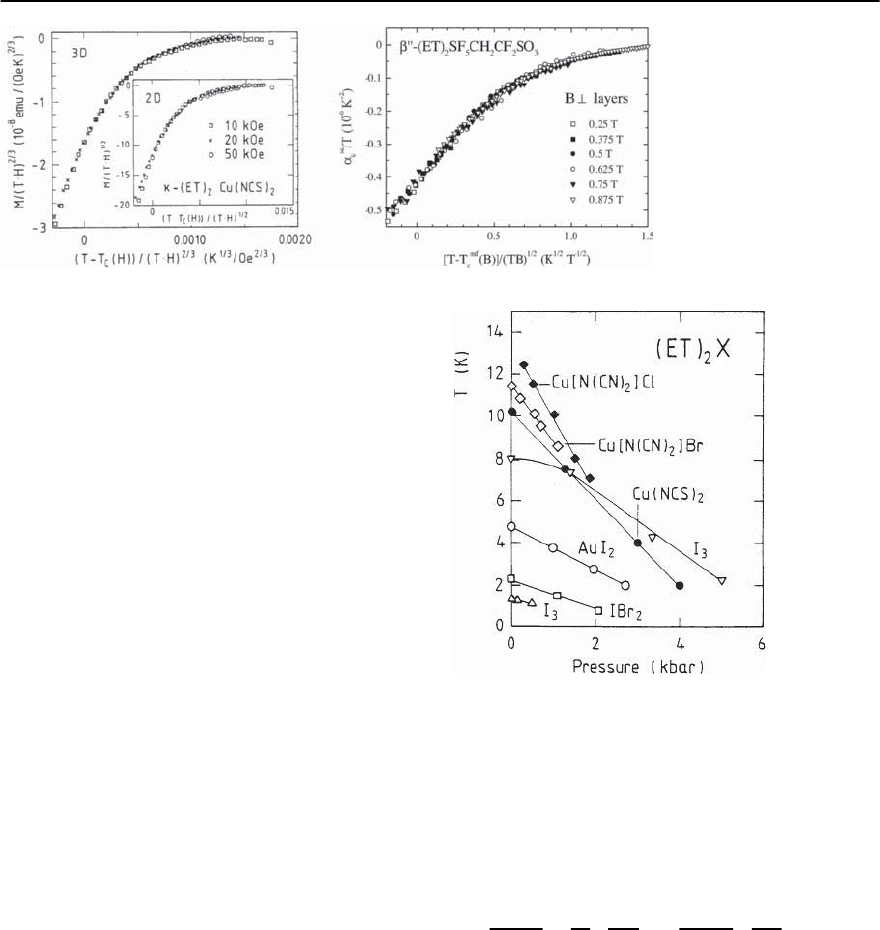
1186 M. Lang and J. M¨uller
Fig. 20.30. Scaling behav-
ior of the superconduct-
ing contribution to the
magnetization of -(ET)
2
Cu(NCS)
2
(left panel) [207]
and the linear coefficient of
thermal expansion of ˇ
-
(ET)
2
SF
5
CH
2
CF
2
SO
3
(right
panel) [151] in magnetic
fields applied perpendicu-
lar to the planes
thermal expansion.
10
As shown in Fig. 20.30 the var-
ious field curves ˛
sc
c
(T, B) show the 2D scaling over
a rather wide temperature and field range, see also
[213,219]. According to the scaling analysis of the
high-field magnetization in Fig. 20.30 as well as the
high-field conductivity in [220],-(ET)
2
Cu(NCS)
2
is
at the threshold from being a strongly anisotropic 3D
to a 2D superconductor.On the other hand,a distinct
2D behavior has been claimed from a scaling analysis
of low-field magnetization data by Ito et al. [221].
Pressure Dependence of T
c
By applying pressure to a superconductor, one can
study the volume dependence of the pairing inter-
action through changes of T
c
. For the (TMTSF)
2
X
and (ET)
2
X superconductors, one generally finds an
extraordinarily high sensitivity to external pressure
and, in the vast majority of cases, a rapid decrease of
T
c
with pressure. Figure 20.31 shows the variation of
T
c
for a selection of ˇ-type and -type (ET)
2
Xsalts
under hydrostatic-pressure conditions. The initial
slope of the pressure dependence of T
c
,
∂T
c
/∂p
p→0
,
determined via resistivity measurements ranges
from −0.25 K/kbar for ˛-(ET)
2
NH
4
Hg(SCN)
4
(T
c
=
1 K) [222] to −3.2 K/kbar for -(ET)
2
Cu[N(CN)
2
]Cl
(T
c
=12.8 K at 0.3kbar) [80]. For (TMTSF)
2
PF
6
,one
finds −(8 ± 1) · 10
−2
K/kbar (T
c
=1.1Kat6.5kbar)
[137].At first glance a strong pressure dependence of
T
c
appears not surprising in view of the weak van der
Waals bonds between the organic molecules, giving
rise to a highly compressible crystal lattice. In fact,
the isothermal compressibility
T
=−∂ ln V /∂p for
Fig. 20.31. Hydrostatic-pressure dependence of T
c
for var-
ious ˇ-type and -type (ET)
2
X superconductors, repro-
duced from [5]
-(ET)
2
Cu(NCS)
2
of
T
= (122 kbar)
−1
[223,224] ex-
ceeds the values found for ordinary metals by about
a factor of five. To account for this “lattice effect”
one should, therefore, consider the physically more
meaningful volume dependence of T
c
:
∂ ln T
c
∂ ln V
=
V
T
c
·
∂T
c
∂V
=−
1
T
· T
c
·
∂T
c
∂p
. (20.12)
Using the above isothermal compressibility, one
finds ∂ ln T
c
/∂ ln V ≈ 40 for -(ET)
2
Cu(NCS)
2
[151]
which exceeds the values found for ordinary metallic
superconductors, as e.g. for Pb with ∂ ln T
c
/∂ ln V =
2.4 [225],or the layered copper-oxides with −(0.36 ∼
0.6) reported for YBa
2
Cu
3
O
7
[226] by 1 ∼ 2orders
of magnitude.
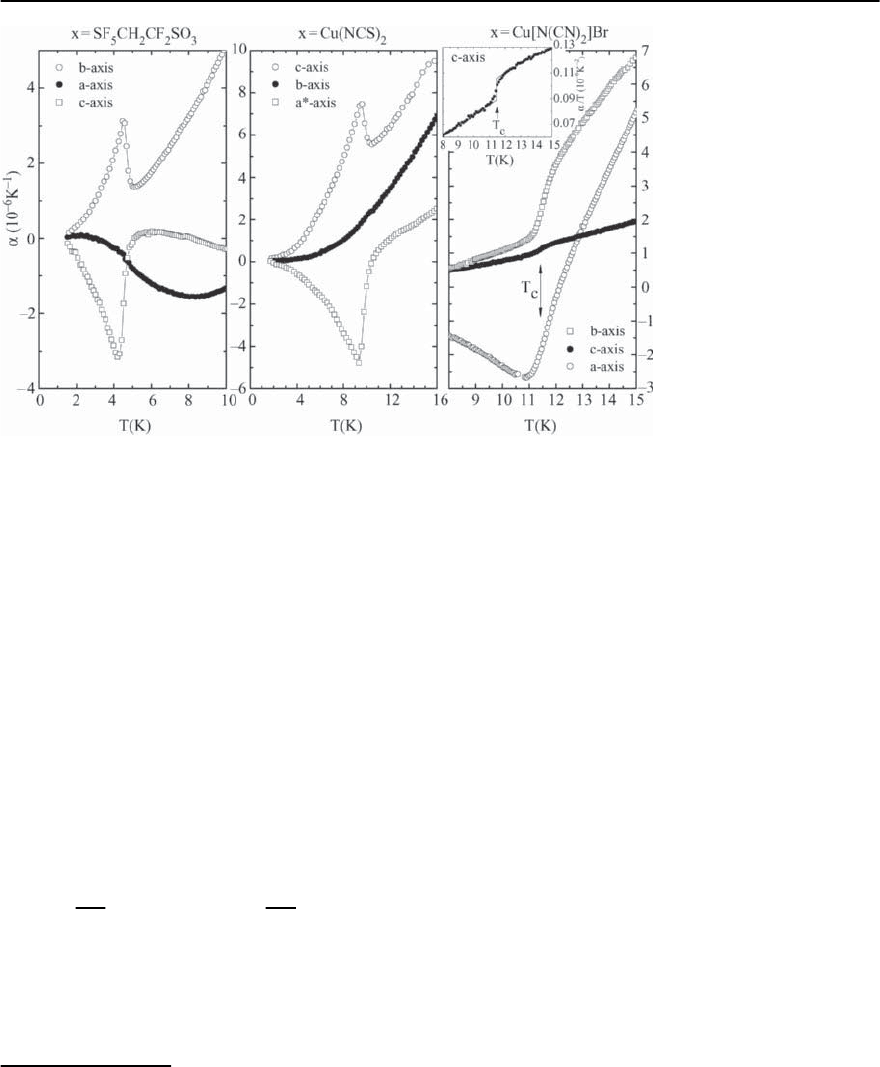
20 Organic Superconductors 1187
Fig. 20.32. Uniaxial co-
efficients of thermal
expansion, ˛
i
,vstem-
perature around the
superconducting transi-
tion for (ET)
2
XwithX
=SF
5
CH
2
CF
2
SO
3
(left
panel), Cu(NCS)
2
(mid-
dle) and Cu[N(CN)
2
]Br
(right panel), taken
from [99, 151, 187]. Open
squares indicate ˛ data per-
pendicular to the planes;
open and closed circles
correspond to the in-plane
expansion coefficients
For strongly anisotropic superconductors like
those discussed here, even more information on
the relevant microscopic couplings can be obtained
by studying the effect of uniaxial pressure on T
c
.
Different techniques have been employed to deter-
mine the uniaxial-pressure coefficients of T
c
for
the (TMTSF)
2
X and (ET)
2
X salts including mea-
surements under uniaxial strain or stress [227–230]
or by using a thermodynamic analysis of ambient-
pressure thermal expansion and specific heat data
[99, 151, 231, 232]. The latter approach is based on
the Ehrenfest relation which connects the pressure
coefficients of T
c
for uniaxial pressure along the i-
axis (in the limit of vanishing pressure) to the phase-
transition anomalies at T
c
in the coefficient of ther-
mal expansion, ˛
i
, and specific heat,C:
∂T
c
∂p
i
p
i
→0
= V
mol
· T
c
·
˛
i
C
, (20.13)
with V
mol
being the molar volume. Figure 20.32
shows results of the linear thermal expansion co-
efficients along the three principal crystal axes
of the superconductors ˇ
-(ET)
2
SF
5
CH
2
CF
2
SO
3
, -
(D
8
-ET)
2
Cu(NCS)
2
and -(ET)
2
Cu[N(CN)
2
]Br. In all
three cases, the uniaxial expansion coefficients are
strongly anisotropic with striking similarities in the
˛
i
’s for the ˇ
and -(ET)
2
Cu(NCS)
2
salts.
Using (20.13), the uniaxial-pressure coefficients
can be derived [99,151]. For -(ET)
2
Cu[N(CN)
2
]Br
one finds ∂T
c
/∂p
b
=−(1.26 ± 0.25) K/kbar for the
out-of-plane coefficient and ∂T
c
/∂p
a
=−(1.16 ±
0.2) K/kbar and∂T
c
/∂p
c
=−(0.12±0.05) K/kbarfor
the in-plane coefficients, employing a jump height
in the specific heat C as reported by [233]. In the
same way, one obtains for ˇ
-(ET)
2
SF
5
CH
2
CF
2
SO
3
−(5.9 ± 0.25) K/kbar along the out-of-plane c-axis
and +(3.9 ± 0.15) K/kbar and +(0.39 ± 0.1) K/kbar
for the in-plane coefficients along the b-anda-
axis, respectively, using the C value given in
[234]. To check for consistency, the hydrostatic-
pressure dependences can be calculated by sum-
ming over the uniaxial-pressure coefficients yielding
∂T
c
/∂p
hydr
=
i
(∂T
c
/∂p
i
)=−(2.54 ± 0.5) K/kbar
and −(1.6 ± 0.5) K/kbar for the and the ˇ
salt,
respectively. These values are found to be in good
agreement with the results obtained by hydrostatic-
pressure experiments, i.e. −(2.4 ∼ 2.8) K/kbar for -
11
Figure 20.32 shows that there is a strikingly similar behavior for the uniaxial thermal expansion coefficients and thus
the uniaxial-pressure coefficients of T
c
of ˇ
-(ET)
2
SF
5
CH
2
CF
2
SO
3
and -(D
8
-ET)
2
Cu(NCS)
2
. The same observation
was made also for the hydrogenated -(H
8
-ET)
2
Cu(NCS)
2
compound [187,232]. Due to the lack of specific heat data

1188 M. Lang and J. M¨uller
(ET)
2
Cu[N(CN)
2
]Br [94,189] and −1.43 K/ kbar for
ˇ
-(ET)
2
SF
5
CH
2
CF
2
SO
3
[234].
11
An obvious step towards a microscopic under-
standing of this class of superconductors is to trace
out those uniaxial-pressure effects which are com-
mon to all systems and thus reflect a generic prop-
erty. Such information would provide a most useful
check of theoretical models attempting to explain
superconductivity and its interrelation with the var-
ious other instabilities in the pressure-temperature
plane. As Fig. 20.32 demonstrates, an extraordinar-
ily large negative uniaxial-pressure coefficient of T
c
for uniaxial pressure perpendicular to the conduct-
ing planes is common to all three superconductors
shown there. Apparently, it is this huge component
which predominates the large response of T
c
under
hydrostatic pressure. On the other hand, and in con-
trast to what has been frequently assumed, the sys-
tems behave quite non-uniformly concerning the in-
plane pressure effects. While for -(ET)
2
Cu(NCS)
2
thein-planepressure coefficientsofT
c
are either van-
ishingly small or positive, they are both negative for
the related -(ET)
2
Cu[N(CN)
2
]Br system [99].
The above finding of a large negative uniaxial-
pressure coefficient of T
c
for pressure perpendicular
to the planes as the only universal feature common
to the -(ET)
2
X family is supported by results on the
related -(ET)
2
I
3
salt, see [236].
12
As has been discussed in [9], a large cross-
plane pressure effect on T
c
may arise from sev-
eral factors: (i) Pressure-induced changes in the in-
terlayer interaction. This effect includes changes of
both the interlayer coupling, i.e. the degree of two-
dimensionality, as well as changes in the electron–
electron and electron–phonon coupling constants
and (ii) changes in the phonon frequencies. Like-
wise, changes in the vibrational properties could
be of relevance for the intraplane-pressure effects
on T
c
. In addition, in-plane stress effectively mod-
ifies the electronic degrees of freedom by chang-
ing the transfer integrals between the HOMO’s of
the nearest-neighbor ET molecules. Most remark-
ably, for some compounds like -(ET)
2
Cu(NCS)
2
the in-plane-stress effect is either positive or zero.
This makes a purely density-of-states effect account
for the pressure-induced T
c
shifts very unlikely:
pressure-induced changes in the density-of-states
should be strongest for in-plane stress owing to the
quasi-2D electronic band structure.According to the
simple BCS relation [237]
T
c
=1.13 Ÿ
D
exp
−
1
with =
N(E
F
)I
2
M ¯!
2
,
(20.14)
where Ÿ
D
denotes the Debye temperature, I
2
the
electron–phonon matrix element averaged over the
Fermi surface, M the ionic mass and ¯! an average
phonon energy, an in-plane-stress-induced increase
in the -orbital overlap, i.e. a reduced density-of-
states at the Fermi level N(E
F
)isexpectedtocausea
reduction of T
c
. This is in contrast to the experimen-
tal observations.
An important piece of information contained in
the above uniaxial-pressure results is that there is
no uniform behavior in the intralayer-pressure ef-
fects on T
c
for the various (ET)
2
X superconductors.
It is especially the results on -(ET)
2
Cu(NCS)
2
which
show that in-plane pressure can even cause an in-
crease of T
c
[151, 230]. This is in contrast to what
has been assumed in the 2D electronic models dis-
cussedin [238,239].Inaddition,thestudies revealed a
predominant effect of uniaxial pressure perpendicu-
lar to the planes clearly demonstrating that attempts
to model the pressure-temperature phase diagrams
by solely considering in-plane electronic degrees of
freedom are inappropriate, see also [240].
for the deuterated salt, the uniaxial-pressure coefficients of -(ET)
2
Cu(NCS)
2
can only be discussed qualitatively. Ac-
cording to a recent comparative study on the pressure dependences of the normal-state and superconducting-state
properties of hydrogenated and deuterated -(ET)
2
Cu(NCS)
2
, the latter compound reveals an even stronger pressure
dependence of T
c
[235].
12
A different situation is encountered for the ˛-(ET)
2
MHg(SCN)
4
salt, where uniaxial pressure perpendicular to the
planes is found to either induce superconductivity by suppressing an ambient-pressure density-wave ground state for
M =K,orenhanceT
c
for M =NH
4
[187,228].This behavior is most likely related to the exceptionally thick anion layers
specific to this compound resulting in a strong decoupling of the conducting layers.

20 Organic Superconductors 1189
Isotope Substitution
Studying the effect ofisotopesubstitutions on the su-
perconducting transition temperature is one of the
key experiments to illuminate the role of phonons
in the pairing mechanism. For elementary supercon-
ductors, the observation of a M
−1/2
dependence of
T
c
where M is the isotopic mass, provided convinc-
ing evidence that the attractive interaction between
the electrons of a Cooper pair is mediated by the
exchange of lattice deformations, i.e. by phonons.
For the -phase (ET)
2
X compounds, the mass-
isotope effect on T
c
has been intensively studied,
see [5], including isotope substitutions in both the
ET donor molecule as well as the charge compen-
sating anions. A most comprehensive study has been
performed by the Argonne group on -(ET)
2
Cu(N
CS)
2
where overall seven isotopically labeled BEDT-
TTF derivatives, with partial substitutions of
13
S,
34
Cand
2
D, as well as isotopically labeled anions
[Cu(
15
N
13
CS)
2
]
−
have been used [128].Aswill be dis-
cussed below in Sect. 20.4.5, these studies revealed a
genuine mass-isotope effect on T
c
.
An “inverse” isotope effect on T
c
has been ob-
served for -(ET)
2
Cu(NCS)
2
where T
c
of deuter-
ated samples -(D
8
-ET)
2
Cu(NCS)
2
was found to
be higher than that of hydrogenated salts, see
[5]. This effect has been confirmed and quanti-
fied by the above mentioned study where partic-
ular care has been taken to guarantee otherwise
comparable quality of both the labeled and unla-
beled crystals [128]. The physical reason for the
inverse isotope effect is still unclear. A geometric
H-D isotope effect has also been found for two
other (ET)
2
Xcompounds
L
-(ET)
2
Ag(CF
3
)
4
(solvent)
and ˇ
-(ET)
2
SF
5
CH
2
CF
2
SO
3
having different pack-
ing motifs and anion structures. Although the T
c
values vary considerably among these salts rang-
ing from 2.9K to 9.2K the investigations reveal an
almost identical “universal” shift of T
c
of T
c
=
+(0.26 ± 0.06) K [241,242]. Taking into account the
results of thermal expansion and X-ray studies of
thelatticeparameters [151,243],it hasbeenproposed
that the inverse isotope effect is not directly related to
thepairing mechanism.Instead it has been attributed
to a geometrical isotope effect, i.e.changes in the in-
ternal chemical pressure: provided that the interlayer
lattice parameter is identical for both compounds,
the effectively shorter C−D bond of the deuterated
salt [244] corresponds to a higher chemical pressure
perpendicular to the planes for the hydrogenated
salt. The negative values of ∂T
c
/∂p
⊥
then result in
ahigherT
c
for the deuterated compound [241,242],
see also [187].
An alternative explanation has been proposed re-
cently by Biggs et al. based on their measurements of
the Shubnikov–de Haas effect focusing on pressure-
induced changes of the Fermi-surface topology of
deuterated and protonated -(ET)
2
Cu(NCS)
2
[235].
It has been suggested that the superconducting
mechanism is most sensitively influenced by the ex-
act topology of the Fermi surface.Since the latter has
been found to change more drastically with pres-
sure in the deuterated salt, this effect might also be
responsible for the inverse isotope effect [235]. In
addition from recent millimeter-wave magnetocon-
ductivity experiments it has been inferred that the
quasi-one-dimensional FS sheets (see Fig. 20.7) are
more corrugated in the deuterated salt (higher T
c
)
suggesting that the “nestability” of the FS may be
important for T
c
[245].
20.4.2 Superconducting Parameters
(TMTSF)
2
X Salts
As a consequence of the highly anisotropic electronic
structure, strong directional dependences are also
expected for the superconducting-state properties
such as the lower and upper critical fields. Among
the (TMTSF)
2
X salts, the latter have been extensively
studied for the ambient-pressure superconductor X
=ClO
4
, see [5,33] and, more recently, also for pres-
surized (TMTSF)
2
PF
6
, see also Sect. 20.4.5 below.
For (TMTSF)
2
ClO
4
the Meissner and diamagnetic
shielding effects have been examined for magnetic
fields aligned along the three principal axes [246].
From these experiments the lower critical field val-
ues B
c
1
(at 50 mK) have been determined to 0.2, 1
and 10 (in units of 10
−4
T) along the a-axis, b-axis
and c-axis, respectively. The thermodynamic criti-
cal field, as estimated from the condensation energy,
amounts to B
c
th
=(44±2)·10
−4
T [247].Figure20.33
